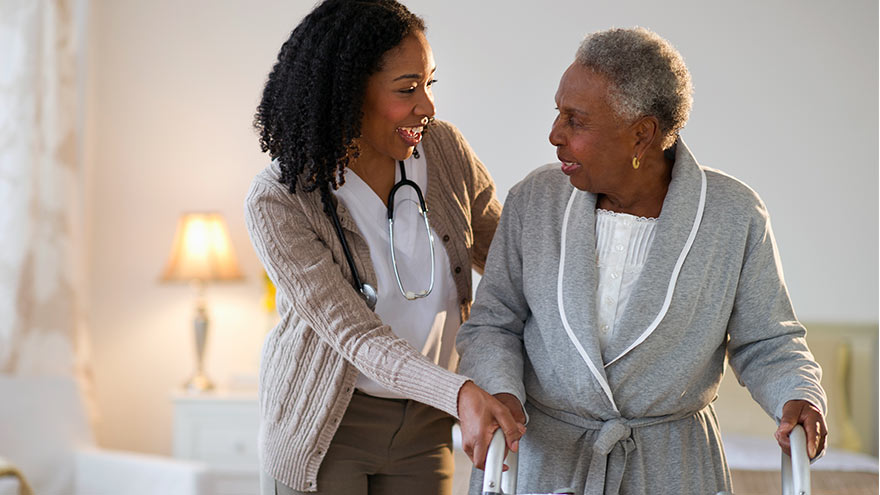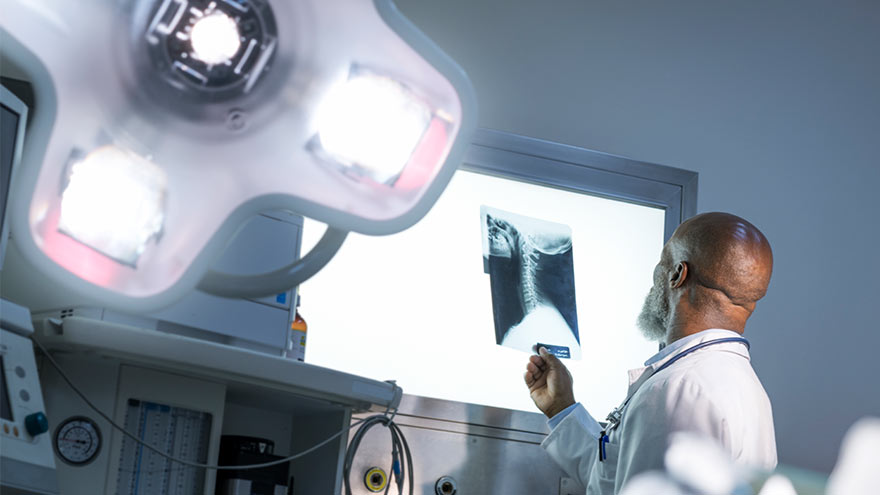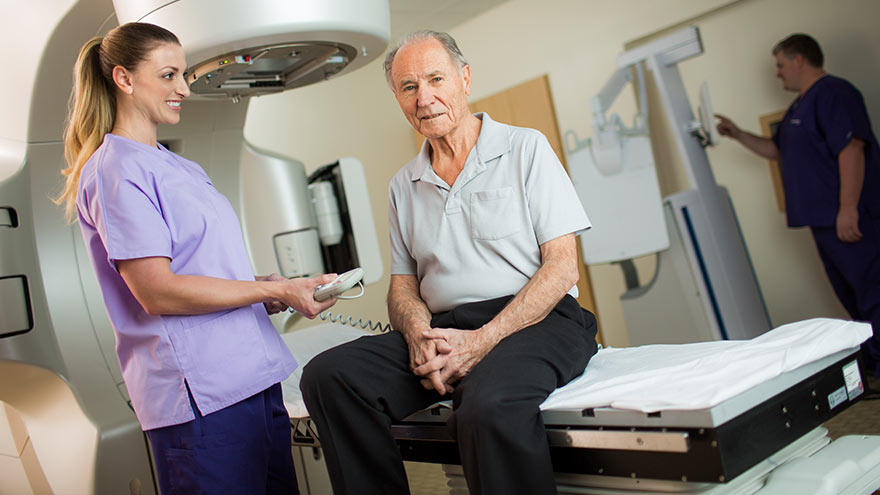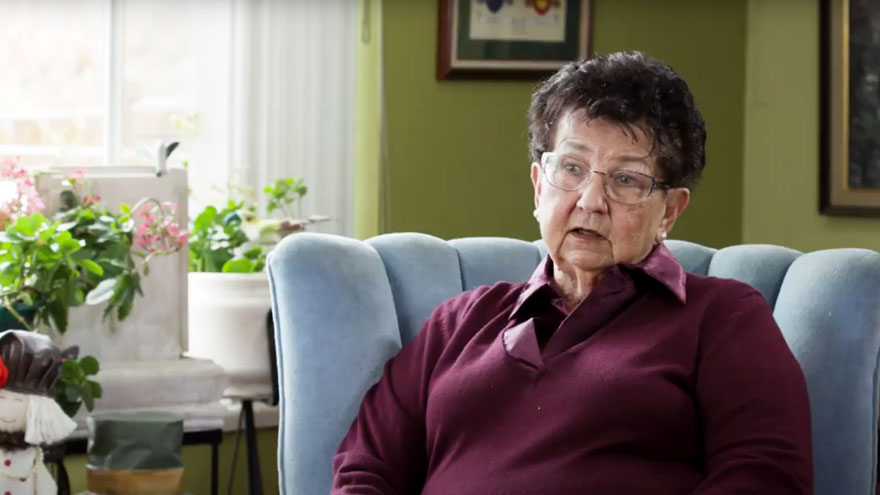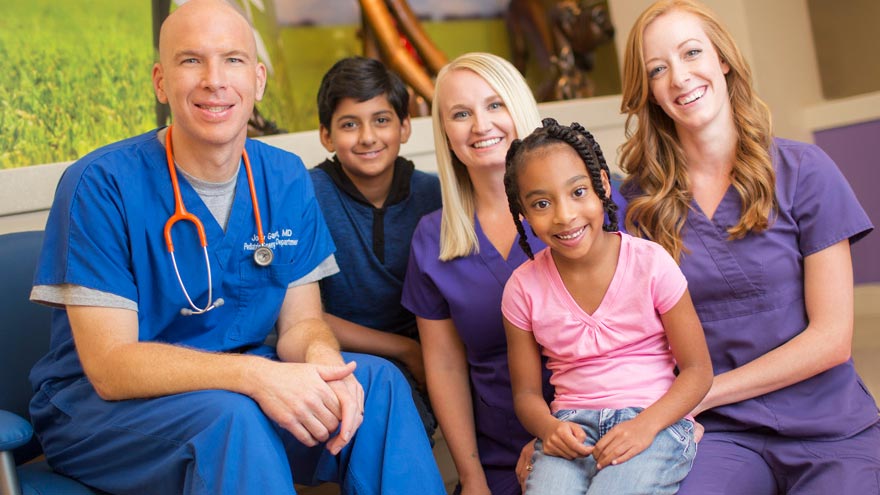Search
-
Know Your Numbers, Save Your Heart
There are some important numbers to know when it comes to good health. Learn more and receive a free blood pressure check at a primary care open house Feb. 27 at Renown Medical Group – Double R. Know Your Numbers Adults are pretty good at knowing and memorizing numbers — from passwords and PINs to addresses and phone numbers. But what about the numbers that could help save your life? Heart disease remains the leading cause of death in the U.S., with 633,842 deaths attributed to the disease in 2016, according to the National Center for Health Statistics. The American Heart Association lists the vital numbers you need to monitor to help prevent heart disease as blood pressure, total cholesterol, blood sugar and body mass index (BMI). With these numbers, your doctor can assess your risk of developing heart issues such as atherosclerosis, which can lead to other serious heart conditions. Atherosclerosis is a condition wherein plaque builds up in the arteries — the blood vessels that transport oxygen-rich blood to cells, the heart and other organs. These fatty deposits clog the arteries, inhibiting blood flow and reducing the amount of much-needed oxygen the body receives. These blockages can lead to angina, coronary heart disease, peripheral artery disease and even heart attack or stroke. But knowing your numbers and keeping them in healthy ranges can mitigate your risk of atherosclerosis and other heart conditions. First things first: Make an appointment with your healthcare provider to see how you’re doing. Learn your numbers and discuss how they may increase your personal risk of heart disease: Total Cholesterol Because cholesterol contributes to the buildup of plaque, keeping your numbers in check means keeping your arteries free of blockages. Check LDL (bad) cholesterol and HDL (good) cholesterol. Your body needs low levels of LDL, but not enough good cholesterol in your system can also increase risk. You can maintain healthy numbers by staying physically active and consuming a heart-healthy diet low in cholesterol and sodium. Statins, the class of drugs used to reduce LDL cholesterol, have proven so effective that the U.S. Preventive Service Task Force recommended in November that all adults older than 40 with one or more risk factors consider taking them. Blood Pressure High blood pressure places undue strain on your heart and arteries to move blood and oxygen throughout the body. And a heart that’s working too hard can lead to stroke, heart attack and heart failure. High blood pressure cannot be cured, but it can be managed by eating a heart-healthy diet low in alcohol, staying active and maintaining a healthy weight. Blood sugar Given that the body converts most of the food we eat into glucose, or blood sugar, for energy, adding sugar to the diet can raise blood sugar to unhealthy levels and damage the heart, increasing risk of cardiovascular disease and obesity. Opt for foods that are low in fat and added sugars and, instead, get your sweets in naturally occurring foods. Let added sugars be a treat and not the norm. Body Mass Index (BMI) Your BMI is used to determine whether you’re at a healthy weight. If you’re carrying extra pounds, the heart has to work harder, which increases risk of heart disease. Losing those pounds and maintaining a healthy weight reduces the burden on your heart and blood vessels and improves your blood pressure and cholesterol levels. So eat a heart-healthy diet and get active — even if you simply walk for 30 minutes a day. Because no symptoms indicate that you have poor cholesterol numbers, high blood pressure or high blood sugar levels, getting screened and learning your numbers is vital. Your doctor can determine what healthy levels look like for you individually and work with you to develop a plan for staying in optimum ranges. That plan will include heart-healthy eating, exercise, abstaining from smoking and, in some cases, medication. It’s up to you to stick with that plan between doctor visits. Do it for yourself, but consider making a pact for a more heart-healthy, active life with a buddy. Research shows people stick with exercise plans longer when they have a partner. This article also appeared in the Reno Gazette-Journal’s Health Source Aug. 27.
-
Learn How to Spot Asthma in Children and How It Is Treated
Sometimes, children’s asthma masks itself in symptoms that can be similar to other common respiratory problems. Dr. Shipra Singh of Renown Medical Group – Pediatrics discusses some diagnoses and treatments for asthma in children. Adults can easily recognize when we are out of breath or struggling to breathe, but what if you noticed this regularly happening to your infant or child during their daily play? Would you think they might have asthma? It may be difficult to tell if your small child has asthma because the symptoms can be similar to other common respiratory problems (bronchitis, croup, pneumonia) or even allergies. Read on to learn how to spot and manage asthma in your infant or child with advice from Shipra Singh, M.D., MPH, Pediatric Pulmonologist at Renown Medical Group – Pediatrics. According to the Centers for Disease Control, asthma in children is a leading chronic illness and cause of school absenteeism in the U.S. Asthma is a multi-factorial disease. Smoking during pregnancy or a family history of allergies or asthma has been linked to a greater chance of developing childhood asthma. Asthma is usually on a spectrum and not a single disease. It can range from mild to severe. Because an infant’s or toddler’s airway is smaller than in older children and adults, even a slight blockage caused by mucus or a restricted airway due to swelling can make breathing hard for them. In children five and younger, one of the most common causes of asthma symptoms is a respiratory virus, which narrows the airways in the lungs. These include a cold, the flu, bronchitis, pneumonia and other illnesses. How can I tell if my child has asthma? Unfortunately small children are unable to describe their symptoms, making asthma difficult to diagnose. Your child may even be active, playing and smiling, although they are experiencing chest tightness or labored breathing. Observe your child and let the child’s doctor know if: Your child’s breathing behavior has changed (coughing, wheezing, rapid breathing) Your child’s breathing pattern changes (day vs. night, with rest or activity, inside vs. outside) You have a family history of asthma or allergies Your child’s breathing is triggered by any foods or allergies With your help, your child’s doctor can make the best diagnosis to determine if your child has asthma. A pediatric pulmonologist (lung specialist) or pediatric allergist may also have to be consulted for special testing. Tests may include lung function testing, allergy tests, blood tests and X-rays for an accurate diagnosis. What is the treatment for infants and toddlers? Young children can use many of the same medications as older children and adults, although the way they take them and the dosage will differ. A nebulizer (or breathing machine) creating a medicated mist for your child to breathe through a mask may be used. An inhaler with a small spacer tube connected to a mask is also common to help your child breath medication into their lungs. Either of these options are effective. Asthma in children is treated with both fast-acting and long-term medicines to open up airways quickly for easy breathing and also to lessen asthma symptoms over time. Communicate with your child’s medical providers to create a personalized asthma management plan for them. How can I manage my child’s asthma? Recognize your child’s breathing habits and be aware of worsening symptoms. Consult with your child’s doctor on a daily asthma action plan to recognize worsening symptoms and track medications. (Here’s an example of an asthma action plan provided by the U.S. Department of Health and Human Services’ National Institutes of Health). Be consistent with the plan and talk to your doctor before changing it. Have an emergency plan in case of a serious asthma attack. Know where the closest ER is and know who can take care of your other children. Also know what the medical treatment coverage is under your insurance plan. We asked Dr. Singh about asthma in children: “Discussing asthma with your child may be a difficult subject. Some kids find the subject frightening or confusing. Others, especially the older kids, may be resentful of the treatment and may not be interested in doing the treatment. Talk to your doctor about advice to build an open and trusting relationship regarding your child’s asthma care.” What can I do to reduce my child’s asthma? Know your child’s asthma triggers (dust, pets, pollen, etc.) Follow your asthma action plan Keep your child away from smoke Can my child outgrow their asthma? Asthma symptoms change day to day and year to year. An older child can better recognize and manage their symptoms, so asthma episodes may lessen. However asthma is a life-long condition of the airways, so it is important to always have an asthma action plan, even with occasional asthma events. Renown Health Pediatric Care | Same-Day Appointments: 775-982-KIDS Our team of pediatricians, specialists and nurse practitioners have specialized training in children’s healthcare needs. We see children from birth to age 18 for the following pediatric needs: Wellness and preventive visits Sick visits Immunizations Behavioral health Allergy Asthma Common cold Diabetes Asthma resources for parents: Asthma and Allergy Foundation of America Centers for Disease Control and Prevention
Read More About Learn How to Spot Asthma in Children and How It Is Treated
-
Want to Recover from Surgery Faster? Get Moving!
To be on the move is a scary concept when you’re recovering from surgery. But did you know getting up and at ’em could be the key to a quicker recovery, post-surgery? Here’s some expert insight from Renown Surgical Services. The team at has some news for you: Rest and movement are important to prevent serious complications. Here are some tips about how to get mobile after your procedure — and why it’s fundamentally important. Tip 1: Start Simple While you’re in bed, move your legs and feet up and down. Be sure to ask the nurses to help you get out of bed and into the chair for all your meals, or walk to the bathroom when needed. If you feel up to it, take a walk in the hallways with the nursing staff. Tip 2: The Sooner, the Better This may be surprising, but too much rest is not necessarily a good thing. The old saying “You use it, or you lose it” rings very true to maintaining the strength needed to get yourself out of bed. Beginning the mobility process early in your hospital stay will not only help you maintain strength and function, it may also help you get home sooner. Though it may seem counter intuitive, lying in bed all day can delay your healing time and cause serious complications to arise, including pneumonia, deep vein thrombosis or blood clots, pressure ulcers and sometimes constipation. Tip 3: Mobilize Your Support System Getting out of bed, sitting in a chair for meals and walking around your room or hospital unit can help reduce your risk of complications. The nursing staff will help you out of bed the same day of your surgery if it’s cleared by your doctor. Tip 4: Safety First The nursing staff is here to keep you safe, so make sure you call them for assistance getting out of bed. Even if you think you can do it yourself, use your call light to notify the nursing staff you are ready to get up and move. In addition, new medications can sometimes impair our judgment, balance and safety, so it’s always better to have help even though you may not need it. This is also why you may have a “bed alarm” on, to remind you to call for help and keep you safe while you are recovering. Tip 5: Move, But Manage Your Pain Many people find that getting up and moving actually helps their pain, rather than making it much worse. Taking the right amount of medication at the right times will minimize your pain and help you to get moving. Your care team will work with you on how much pain medication is right to manage any postoperative pain, with the goal for you to be comfortable enough to be able to move and gradually increase your activity each day. Tip 6: Maintain that Momentum at Home Mobility doesn’t end once you’re discharged from the hospital. It’s key to keep moving to maintain health and function. When you first arrive home, it’s crucial to take frequent movement breaks throughout the day. Increase activity as it becomes more comfortable, and be sure to ease back into an active daily routine. If you have concerns about your mobility once home, be sure to discuss this with your doctor at your follow-up appointment. Renown Surgical Services | 775-982-3993 Ask your doctor if you have any questions about your medical condition or the specific surgical procedure planned, or contact the team at Renown Surgical Services. Learn More
Read More About Want to Recover from Surgery Faster? Get Moving!
-
Early Onset of Puberty in Girls on the Rise
Many factors are contributing to the rise of early onset puberty in girls. Learn what they are below and how you can support your daughter. The number of girls experiencing early puberty has increased dramatically over the last few years and continues to grow. More and more girls in the U.S. are starting to show signs of development before the age of 8. Recent studies show that up to 10 percent of Caucasian girls and 23 percent of African American girls are showing signs of puberty by age 7. What’s Contributing to Early Puberty in Girls? Determining the exact cause is difficult. But experts agree that several factors may be contributing to these growing numbers. Increasing rates of childhood overweight and obesity. Excess body fat alters the levels of hormones responsible for the acceleration of pubertal timing. Physical inactivity may decrease melatonin levels, which can also trigger pubertal development. Increased animal protein intake. Higher total protein, animal protein and meat intake in children ages 3 to 7 have been associated with earlier onset of menstruation. High protein intake elevates IGF-1 levels and promotes growth, which could accelerate the onset of puberty. Poor diet. Children with lower-nutrient diets tend to enter puberty earlier. A diet rich in processed foods and meats, dairy, and fast food is disruptive to normal physical development. Exposure to EDCs (endocrine-disrupting chemicals). EDCs are synthetic chemicals found in plastics, pesticides, fuels and other industrial chemicals that inhibit or alter the action of natural hormones. Because EDCs accumulate in the fatty tissues of animals, animal foods contain higher levels of these chemicals than plant foods. Exposure to BPA (bisphenol A). BPA is an industrial petrochemical found in a variety of products including plastics, tin-can linings and even cash register receipts. Because it acts as a synthetic estrogen it may speed up pubertal development. Soy products. Soy contain isoflavones which are converted to phytoestregens in the body, and are similar to the hormone estrogen, Dr. Chelsea Wicks says. “Soy consumed from natural food sources is likely safe and will not cause abnormal hormones levels. However, when consumed in large amounts, such as with soy supplements or in more processed foods, there have been links to chronic medical problems due to elevated estrogen levels. I feel a good answer to this is to continue working on eating fresh foods and trying to avoid the processed, packaged foods as this will be best for overall general nutrition as well,” she adds. What You Can Do While some genetic factors play a role in the early onset of puberty, parents can help lessen environmental causes of the condition. Encourage and help your child to maintain a healthy weight with proper nutrition and exercise. Avoid exposure to hormones such as estrogen and testosterone that may be found in hair products, medications and nutritional supplements. Avoid exposure to EDCs and BPA. Offer your child a diet centered around whole plant foods rather than animal foods, which will help keep protein intake within a safe range and reduce consumption of EDCs. Create a supportive environment for your daughter. Avoid commenting on her appearance and instead focus on her achievements, academic successes or artistic talents. Speak to her openly and honestly about the physical changes she’s experiencing — that although these changes are normal, she’s simply developing early — and that ultimately her peers will undergo the same changes. Encourage your daughter to continue participating in social activities and pursuing her interests, and reassure her you are always open to discuss any questions or worries. If you are concerned that your child may be going through these changes before expected, speak with your pediatrician. Sources: Early Puberty: Causes and Consequences When Is Puberty Too Early? Precocious Puberty (Early Puberty) Precocious Puberty
-
Want to Eat for Heart Health? Consider a Plant-Based Diet
Maintaining a healthy weight has many benefits: among those is improved heart health. If you’re trying to eat right as well as become healthier, nutrition experts say you might want to consider a plant-based diet. Plants provide air to breathe, beauty in our surroundings — and just may be a viable solution to your weight-loss goals. According to the Centers for Disease Control and Prevention, more Americans than ever are overweight: Today, 7 in 10 Americans are classified as “obese” or “overweight,” and childhood obesity rates are growing rapidly. So experts encourage would-be dieters to look to plants as a source of daily inspiration. “When you slowly and consistently expand your daily food choices to include more plant-based options, you will feel fuller, have more energy and lose weight,” says Lynice Anderson, director of Renown’s Healthy Heart Program. But according to a recent study from the U.S. Centers for Disease Control and Prevention, just 1 in 10 adults eats enough vegetables and only 12 percent get the recommended amount of fruit daily. The same study notes that eating a diet rich in fruits and vegetables daily can help reduce the risk of many leading causes of illness and death, including heart disease, type 2 diabetes, some cancers and obesity. Plant Foods = Foods with Fiber One of the overwhelming health benefits of plant-based foods: fiber. A study published in a recent issue of the Annals of Internal Medicine suggests that something as simple as aiming to eat 30 grams of fiber each day can help you lose weight, lower your blood pressure and improve your body’s response to insulin just as effectively as a more complicated diet. Fiber contains no calories and comes in two forms: soluble, which dissolves in water, and insoluble, which doesn’t dissolve. Both are important for different reasons. The soluble fiber found in oats, fruits and beans forms a gel-like substance and helps to lower blood cholesterol and blood sugar levels. Insoluble fiber found in fruit skins, green beans and cauliflower goes through your intestines relatively intact providing “bulk” and improving bowel-related health problems. “My fiber champion is chickpeas, also known as garbanzo beans,” says Renown Chef Chris Wyatt. “They are high in fiber, low in fat, low sodium and have zero cholesterol. Not only do they not contain any cholesterol, chickpeas work to remove cholesterol from your body. It’s a win-win.” Snacks That Are Part of a Plant-Based Diet Looking for the best sources of fiber from the plants and trees in your life? Here are the best options, according to this CDC fact sheet: Fruits Raspberries, 1 cup: 8.0 grams of fiber Pear, with skin, 1 medium: 5.5 grams of fiber Apple, with skin, 1 medium: 4.4 grams of fiber Strawberries (halved), 1 1⁄4 cup: 3.8 grams of fiber Banana, 1 medium: 3.1 grams of fiber Orange, 1 medium: 3.1 grams of fiber Veggies Artichoke, cooked, 1 medium: 10.3 grams of fiber Peas, cooked, 1 cup: 8.8 grams of fiber Broccoli, boiled, 1 cup: 5.1 grams of fiber Turnip greens, boiled, 1 cup: 5.0 grams of fiber Sweet corn, cooked, 1 cup: 4.2 grams of fiber Brussels sprouts, cooked, 1 cup: 4.1 grams of fiber Potato; with skin, baked, 1 medium: 2.9 grams of fiber Carrot, raw, 1 medium: 1.7 grams of fiber Renown Health Improvement Programs | Appointments: 775-982-5073 Renown Health offers a number of educational and support programs to help people overcome the challenges presented through various health conditions and to aid in creating and adopting a healthy lifestyle. To get an assessment of your dietary needs, schedule a consultation with one of Renown’s registered dietitians, who can help with: Diabetes Programs Medical Weight Management Nutrition Programs Make an Appointment
Read More About Want to Eat for Heart Health? Consider a Plant-Based Diet
-
Head, Neck and Oral Cancers: How You Can Spot and Treat Them
Head, neck and oral cancers account for just 3 percent of all cancer in the U.S. and can be hard to diagnose. Dr. Abhinand Peddada, radiation oncologist with the Renown Institute for Cancer, explains. While you likely don’t frequently hear about head, neck and oral cancers — they are significantly less common than many kinds of cancer — they can be extremely dangerous. One of the primary reasons: some symptoms mimic the common cold, making them difficult to detect without a medical professional. We asked Abhinand Peddada, M.D., radiation oncologist with the Renown Institute for Cancer, to break down the symptoms and lifestyle risks of these rare cancers. First off, what are some of the signs and symptoms of head, neck and oral cancers? Symptoms can vary based on where the cancer is. For example, throat cancer may show up as a persistent sore throat, while sinus cancer may present as soreness or pressure in the sinuses that doesn’t get better. Some other symptoms to watch may include: Swelling in the throat Painless swelling in the neck Red or white patches in the throat Hoarseness Bloody noses or blood in the mucus or saliva A new and unexplained lump or bump anywhere on the face, neck, mouth or throat Difficulty breathing Difficulty swallowing, chewing or moving the muscles in your face, neck, mouth or throat Bad breath, even with good oral hygiene Loose teeth Dentures or retainers that no longer fit Double vision Who is most at risk for head, neck and oral cancers? Both men and women can develop head, neck and oral cancers, but men are at almost twice the risk of women. People over the age of 40 are also at a higher risk, and these cancers tend to be more common in African Americans. Tobacco use — including cigarettes, cigars, pipes and chewing tobacco — is another risk factor. Tobacco is linked to 85 percent of head and neck cancers. Exposure to fumes and chemicals can increase your risk as well. We’re also seeing more HPV-related head and neck cancers in the U.S., so patients with HPV may want to watch more closely for symptoms. What about screening and prevention? Your dentist already looks for signs and symptoms at your regular dental checkups. Additionally, if you have one of these risk factors and are experiencing signs and symptoms, it’s a good idea to check with your doctor about possible screenings. To help prevent these types of cancers, try to minimize your controllable risk factors. This means quitting tobacco, watching your alcohol consumption and taking care of your oral hygiene by brushing and flossing regularly. We also recommend the HPV vaccination for both boys and girls starting at age 11. By vaccinating at an earlier age, one is less likely to develop oral HPV. What do diagnosis and treatment look like for these cancers? At Renown Institute for Cancer we offer the most advanced diagnostic testing available including fiberoptic photos, CT and PET scans, as well as MRIs. Together, you and your care team will decide which treatment best fits your needs. For these types of cancers, treatment options include radiation, chemotherapy and surgery. Renown Institute for Cancer | 775-982-4000 At the Renown Health Institute for Cancer, our experienced team provides the support and care to maintain the highest quality of life and then achieve the best possible outcome, all in one location that’s close to home. Our dedicated team, clinical expertise and advanced treatment options allow us to tailor care to each patient. Learn about: Our Team Cancers We Treat Screening and Prevention Treatment Options Find a Cancer Doctor
Read More About Head, Neck and Oral Cancers: How You Can Spot and Treat Them
-
Why Didn't You Tell Me? 10 Pregnancy Surprises, Revealed
We asked, you answered: Moms and dads who have been there, done that offer up 10 pregnancy surprises. These are the things they wish they knew before, during and after their pregnancy. Check out these real examples of insights that would have proved helpful and enlightening to these parents and parents-to-be. When you’re pregnant or considering becoming pregnant, it seems the unsolicited advice runs rampant. You’ll hear people tell you what kind of Boppy Pillow to buy. You’ll have people tell you that you should “definitely” have a natural birth or a pool birth or a doula or a therapy dog present. And you’ll definitely hear about what kinds of foods to induce labor, what kind of tea to drink to reduce nausea during your pregnancy and what kind of underwear for less “chafing.” But something you might not hear as often: Some of the symptoms and side effects, both before and after giving birth, that were totally unexpected. These are the ultimate pregnancy surprises. So we asked the question of moms and dads who have been there, done that: What do you wish you had known would happen during your pregnancy — you know, during the time you were supposed to be all sweet and beautiful and glowing? Here is Part 1, featuring 10 real-life, crowdsourced pregnancy surprises from parents. And yes, there are multiple parts to this post, because people are passionate about sharing their wisdom! We’ll publish the second part later this month. Pregnancy surprises: What do you wish you had known about pregnancy? “The only symptom I never heard anyone talk about is extra blood flow making me feel all sorts of weird feelings in my head. I feel like I’m in a dream half the time. I looked it up online when it started happening, and tons of women have the same symptom.” — Anna K. “For me it was an after-birth surprise. I had no clue your tummy doesn’t just spring back to where it was pre-pregnancy. It was a rude awakening in the hospital when I had to have my husband go home and get a pair of maternity sweatpants to get dressed to go home in. I’d hoped to dress in my old cute jeans…. nope!” — Suzanne M. “I didn’t know that while you’re pregnant, friends and strangers would tell you their nightmare delivery stories. Oh — and that complete strangers will, uninvited, touch your baby bump. I didn’t know that you’re in the safety zone while pregnant and that men and women openly adore you. I didn’t know that besides the mother, the nurses do most of the work. I didn’t know that even though they’ve obviously seen hundreds of deliveries, nurses and doctors cry too once your baby is out. I didn’t know even though I thought they must be crazy to send a tiny human home with me, that you instinctively know how to parent. I didn’t know what it meant to love something more than myself and how that changes everything.” — Cathy B. “I had no idea the weird things that it does to hair. My bangs stuck straight out for months, and I just had to go with it. There wasn’t enough product that would make them lie down.” — Heidi P. “That you may not go home with your child if there are any complications. That was a sad day. But 22 years later, we are blessed, because everything turned out fine.” — Kristine F. “I didn’t know people would opine out loud to you, that you must not have purposely gotten pregnant with Baby #2 or 3, etc., implying you failed basic high school biology and that you should have known better than to have more than one kid.” — Jessica L. “I didn’t know that near the pregnancy’s end, as the hips widen, that those bones could begin to separate. I was sore and achy. And I wish I’d slowed down and rested more in the last few weeks.” — April C. “I had heard about food cravings, but no one told me food aversions were also a thing. I bought a whole load of groceries for the week, and by the time I got home, I suddenly couldn’t even look at the ground turkey (that’s not an exaggeration), let alone cook it and eat it. I didn’t throw up necessarily, but my body told me to avoid most meats and vegetables. I pretty much lived on plain bagels and cereal for half my pregnancy.” — Danielle S. “Morning sickness is SO not just in the morning! All-the-time sickness is what I experienced. And why didn’t anyone warn me about butthole pain during and after birth?” — Stephanie C. “The juiciness. Every possible secretion was in hyper drive.” — Jane F. Giving Birth at Renown At Renown Regional Medical Center we have the skill, expertise and technology — along with a friendly environment — to make your experience a memorable one. Pre-register for childbirth, take virtual tours of our rooms and facilities, and learn more about our labor and delivery offerings at the link below. Explore Our Services
Read More About Why Didn't You Tell Me? 10 Pregnancy Surprises, Revealed
-
What Is the Importance of Having an Institute for Cancer?
What is an institute for cancer — and why does it matter that we have one right here in Reno? Here, a radiation oncologist answers those questions and more. Sadly, our community health needs assessment shows cancer is the second leading cause of death in Washoe County. But many residents may not know there is an institute for cancer right here in Reno that can care for you or your loved one after diagnosis. Dr. Michael Hardacre, a radiation oncologist with Renown Institute for Cancer is here with more. What is an institute for cancer? The way I like to think of it: An Institute has healthcare providers highly trained in patient-centered care. For example, when you have cancer, many times you’ll see a lot of doctors. A program brings those doctors together — so you really have one team working together. An Institute takes that one step further. Say there are other needs beyond the doctor’s office such as nurse navigators, dietitians, physical therapists to help you get on track, etc. An Institute really proactively thinks of the need of the cancer patient. It then makes sure all those things are available to them throughout their treatment. The term “institute for cancer” identifies a cancer program that is comprehensive and multidisciplinary in nature. For Renown, that means that we have the specialists in medical oncology, surgical oncology and radiation oncology working together with other specialists to assure that a patient has coordinated care throughout the entire treatment course of cancer care. Together with cancer prevention and diagnostics, genetic assessment, supportive care, clinical trials, and cancer survivorship, the institute for cancer provides care for the community, families and patients along the entire spectrum of cancer care. What types of cancer do you treat? We’re fortunate to be able to provide cancer treatments for all types of cancers, and we’re one of the major referral centers for northern Nevada. Most commonly, just like much of the country, lung cancer, prostate cancer and breast cancer are the most frequent we see. Our care spans brain, to neck cancer and everything in between. As an accredited comprehensive community cancer program, Renown Health provides services for all cancer types. The highest volume cancers treated at Renown are breast, colorectal, lung, genitourinary, blood and gynecologic cancers. Most treatments can be done right here in Reno, but when there are specialty needs such as stem cell or bone marrow transplantation, we partner with quaternary centers, like Stanford, to assure a smooth transition of care both to and from the quaternary center. What kinds of care and treatments are offered? We offer a wide range of comprehensive care. We treat the cancer itself — surgical, radiation oncology, medical oncology in the form of chemotherapy or pills. Also addressed: dietary needs, physical therapy and navigation through this whole process. People may be surprised by the scope and scale of the Renown Institute for Cancer. For instance, our Radiation Center has the latest technologies to treat cancers. This includes the Linear Accelerators, which are machines with treatment planning software tools. In addition to the traditional external radiation treatments provided in most centers, Renown performs specialty treatments using High-Dose Brachytherapy, a treatment with an active radiation “source” and in Brain Stereotactic Radiosurgery, assuring that patients can stay right here in northern Nevada — close to home. What does that mean for the quality of care? I think it’s always great in any environment to have external people come into your program and not only share what’s happening nationally and what we could do better, but also to validate “are you doing things at the highest level you can?” That accreditation process is just one way to give us that seal of approval. We’re lucky enough this year to get the gold award by the American College of Surgeons — its highest honor. We were honored to receive it. Why is important that you’re an accredited institute? Accreditation assures our community that quality is a top priority for us. Each of the accrediting bodies has a set of standards that identify service and quality standards. Renown Institute for Cancer has the following accreditations: American College of Surgeons’ Commission on Cancer: Full Cancer Program accreditation, standards address issues from cancer prevention/diagnosis to treatment to survivorship and/or end-of-life. Renown received the Gold Level Accreditation in 2018, the highest level of accreditation possible; American College of Surgeons’ National Accreditation Program for Breast Centers: Full Breast Center/Program accreditation, standards address issues from breast cancer prevention/diagnosis to treatment to survivorship and/or end-of-life; American College of Radiology – Radiation Therapy: Full Radiation Oncology accreditation for radiation equipment, treatment planning, treatment and treatment follow-up; and American College of Radiology – Mammography Services.
Read More About What Is the Importance of Having an Institute for Cancer?
-
Happy and Healthy Life After Heart Valve Replacement Surgery
Watch what happens when a family’s matriarch finds out she has to have heart valve replacement surgery. Thanks to supportive cardiac care, she is now back to health and enjoying her extended family with a healthy heart. Marilyn O’Gorman has a full heart full of love: Just ask her six children, 15 grandchildren and six great grandchildren. However, in 2009, tests showed that same heart had medical issues. So her close family was by her side when she underwent heart valve replacement surgery. O’Gorman says her heart doctor, Athan Roumanas, MD, FACS, put her at ease about the surgery. “You’re very nervous — you’re scared,” says O’Gorman. “You don’t know: Are you going to come out of it? Is it going to work?” Heart Valve Replacement Surgery Comes with an Unexpected Question O’Gorman was asked to choose whether she’d prefer a pig or a cow valve — ultimately inquiring of Dr. Roumanas which one he’d choose for his own mother. “And he said, ‘Well, probably pig,'” she recalls. “And I said, ‘OK, I’ll oink for you.’ And that’s how I got that, and he did a wonderful job.” O’Gorman continues her care at the Renown Institute for Heart and Vascular Health, so she can stay heart healthy and spend her free time with the many generations of family in her life.
Read More About Happy and Healthy Life After Heart Valve Replacement Surgery
-
How to Safely Give Children Over-the-Counter Medications
How can you ensure you’re giving your children safe doses of over-the-counter medications? The safest bet: Confirming dosages and recommendations with your doctor. With that in mind, here are a few answers to basic questions about OTC medications and children. It’s cold and flu season in Northern Nevada. This means you’ll find parents in the aisles of practically every drug store, wondering what will and will not work for their sick children. Over-the-counter (OTC) medications — and their dosages, side effects, interactions and more — can inspire abundant anxiety for parents. At the outset, the U.S. Food and Drug Administration offers the following warning about use of medicines for cough and colds in children: The FDA doesn’t recommend over-the-counter medicines for cough and cold symptoms in children younger than 2 years old. Prescription cough medicines containing codeine or hydrocodone are not indicated for use in children younger than 18 years old. Codeine and hydrocodone are opioids that are available in combination with other medicines, such as antihistamines and decongestants, in prescription medicines to treat cough and symptoms associated with allergies or the common cold for adults. Caregivers should also read labels on OTC cough and cold products, because some might contain codeine. So how can you feel comfortable administering any OTC medication to your children? The short answer is: Check with a doctor first. And with that in mind, here are a few common questions and answers from Kristin L. Wilson, MD, of Renown Pediatrics about children and OTC medications. Please talk about the importance of correct dosage of pediatric medications. Pediatric dosing is weight-based and unique to each medicine (and sometimes even the circumstance you are treating.) Therefore, there are no standardizations of “safe” amounts that apply to all medications. What are signs of an overdose of pediatric medications? Signs of intoxication/overdose are also unique to each medication and supplement. And to make it more confusing, mixing current prescriptions with various supplements or over-the-counter medications can cause significant adverse effects as well. Is there an age at which children take adult over-the-counter medications? Infants through adolescents can take medications that are also prescribed to adults, but only under a healthcare provider’s careful guidance. Dosing is determined by various factors dependent on child’s age and also medical history, as above. What is the takeaway about administering medications to children? When in doubt, ask a healthcare professional whether a medication or supplement is safe for your child based on his/her age and medical history as well as recommended dosing based on recent weights and other vital signs.
Read More About How to Safely Give Children Over-the-Counter Medications
-
Children's ER, Urgent Care or Wait it Out? Here's Your Guide
We’ve all been there: Your child gets sick right after urgent care closes — or worse, in the middle of the night. So do you wait it out, or do you load up and head to the Children’s ER? Pediatric Emergency Physician Joey Gassen, MD, with Northern Nevada Emergency Physicians, has insight. As parents, we often wish we had all the answers. And while a short-and-sweet comprehensive parenting guide is elusive, we can help if your questions involve whether to go to the children’s ER or wait it out. Here, a pediatric emergency physician explains when you should take your child to the Children’s ER at Renown Children’s Hospital, and what makes a children’s ER different. How do you know when it’s time to take your child to the ER? Having a sick or injured child is stressful. If you have a true emergency, you should go straight to the ER or call 911. When to go to the ER: Allergic reactions Asthma or severe shortness of breath Fever (infants less than two months old) Choking or poisoning Coughing up or vomiting blood Fainting, confusion or seizures Fractures or broken bones Head injuries Severe bleeding If you determine your child’s condition isn’t life-threatening but needs to be taken care of right away, urgent care is the best choice. Those conditions include: Cold and flu Coughs and sore throat Fevers Vomiting, diarrhea, stomach pain Cuts and severe scrapes Minor injuries and burns What is different about Renown Children’s ER compared to the adult ER? The difference starts when you first bring your child in. We have a lobby dedicated to our community’s smallest patients. The 24/7 lobby incorporates a child-friendly atmosphere with vibrant colors to help decrease anxiety that can accompany emergency situations. Our children’s ER also has equipment sized just for kids of any age. We offer a distraction machine, as well as games and movies, to help children cope with what can be a traumatic experience, like getting an IV. In addition, we have Child Life Specialists available to provide the emotional support to both children and their families. Why is it important to have an emergency room and lobby open 24/7 dedicated to children? Children aren’t just little people. They have special needs that require specialized care. Our children’s ER is staffed with skilled physicians and pediatric nurses certified in advanced pediatric emergency care to give your child the highest level of support. Renown Children’s Hospital From newborns to teens, Renown Children’s Hospital offers many different services and treatments designed specifically to take care of our community’s children. We provide a range of specialized services — from a dedicated Children’s ER and Pediatric ICU to a children’s imaging center and child’s asthma program. Explore Children’s Services
Read More About Children's ER, Urgent Care or Wait it Out? Here's Your Guide
-
Healthy Veggie Chili, Ready to Eat in Less than an Hour? Yes Please!
We’re always in search of cozy comfort foods for crisp winter evenings, but you know what’s even better? When the recipe takes less than an hour, start to finish. Here’s a recipe for healthy vegetarian chili that you can customize with your favorite beans. Remember those Choose Your Own Adventure books you used to read as a child? Well here’s a Choose-Your-Own-Adventure-inspired veggie chili. The adventure: Customizing it with your favorite beans! And once your selections are made and the veggies are chopped, this recipe should take about 40 minutes to prepare, from beginning to satisfying end. Vegetarian Chili Feeds the Crowds Here’s the recipe, which is fully customizable based on bean preferences and can also be adapted to slow cooking.
Read More About Healthy Veggie Chili, Ready to Eat in Less than an Hour? Yes Please!


